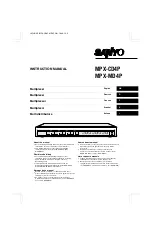
DM16E1 / DM4E1 Operation and Installation Manual - 204-4001-19
11
1.
INTRODUCTION
DM16E1 and DM4E1 are E3, PDH (Plesiochronous Digital Hierarchy) multiplexers.
They can work with electric or optic aggregate interfaces. There are two slots for aggregate cards, which
allow for backup or ring operation.
In addition, the equipment counts on four E1 G.703 ports for tributaries in the DM4E1 model and on 16 E1
G.703 ports in the DM16E1 model. Both models have a V.35-V.36/V.11 port, an Ethernet 10BaseT port
with clearing functions, and the option to install an Ethernet Remote Bridge 10/100BaseT card.
DM16E1 and DM4E1 carry out multiplexing in accordance with G.742 (four E1 for E2 channels) and G.751
(four E2 for E3 channels) ITU-T recommendations.
In the DM16E1 model, E1 tributary interfaces can be supplied with BNC or IEC connectors for 75 ohms or
RJ45 for 120 ohms. The type of connector required should be specified when purchasing.
In the DM4E1 model, E1 tributary interfaces can be supplied with BNC or IEC connectors for 75 ohms. The
type of connector required should be specified when purchasing. RJ45 connectors for 120 ohms are
always supplied with the equipment.
A clock´s external reference is not necessary to operate the equipment. Although, a clock´s external
reference can be supplied in order to generate AIS on E1 channels.
Equipment programming can be carried out via a VT100 terminal or via a standard IBM-PC® computer,
using a VT100 terminal emulation software. The connection of the terminal to the equipment is made with
an RS-232 serial cable.
The equipment can be managed via SNMP either by the Ethernet port, on the front panel, or in band,
utilizing routing or remote management.
SNMP management is also available through the DmView application software, which runs over an HP
Open View platform. The application is able to manage a whole network, making it possible to configure,
check status, carry out tests, etc., in every network equipment.
DM16E1 and DM4E1 are physically constituted of a basic unit for mounting in 19” racks with 1,5 units of
height.
Regarding power supply, they can operate with two units of redundant power operation (Main and
Backup). The supply unit can be AC (93 to 250 V) or DC (36 to 72 V), with automatic selection. The
backup unit is identical to the main unit and is optionally supplied.
Aggregate cards and units can be inserted or removed with the equipment switched on and in operation
(hot swap).
The DM16E1 and DM4E1 equipment have a voice service channel with point-to-point, point-to-point optical
modem, regular ring, regular ring optical modem, cross ring and cross ring optical modem topologies.
There is an RJ11 connector on the front panel for a common telephonic device connection. Once the
telephone is off of the hook, an indication will be activated through sonorous alarm at the remote
equipment. The voice channel operation does not modify the data flow.
The multiplexers enable the performance of local digital and local analog loopbacks (LDL and LAL) on E1
and E3 interfaces, in addition to LDL and BERT on V.35-V.36/V.11 interfaces.
They also allow the removal and insertion of E1 signals in any point of the ring. And are provided with a
relay alarm output.












































